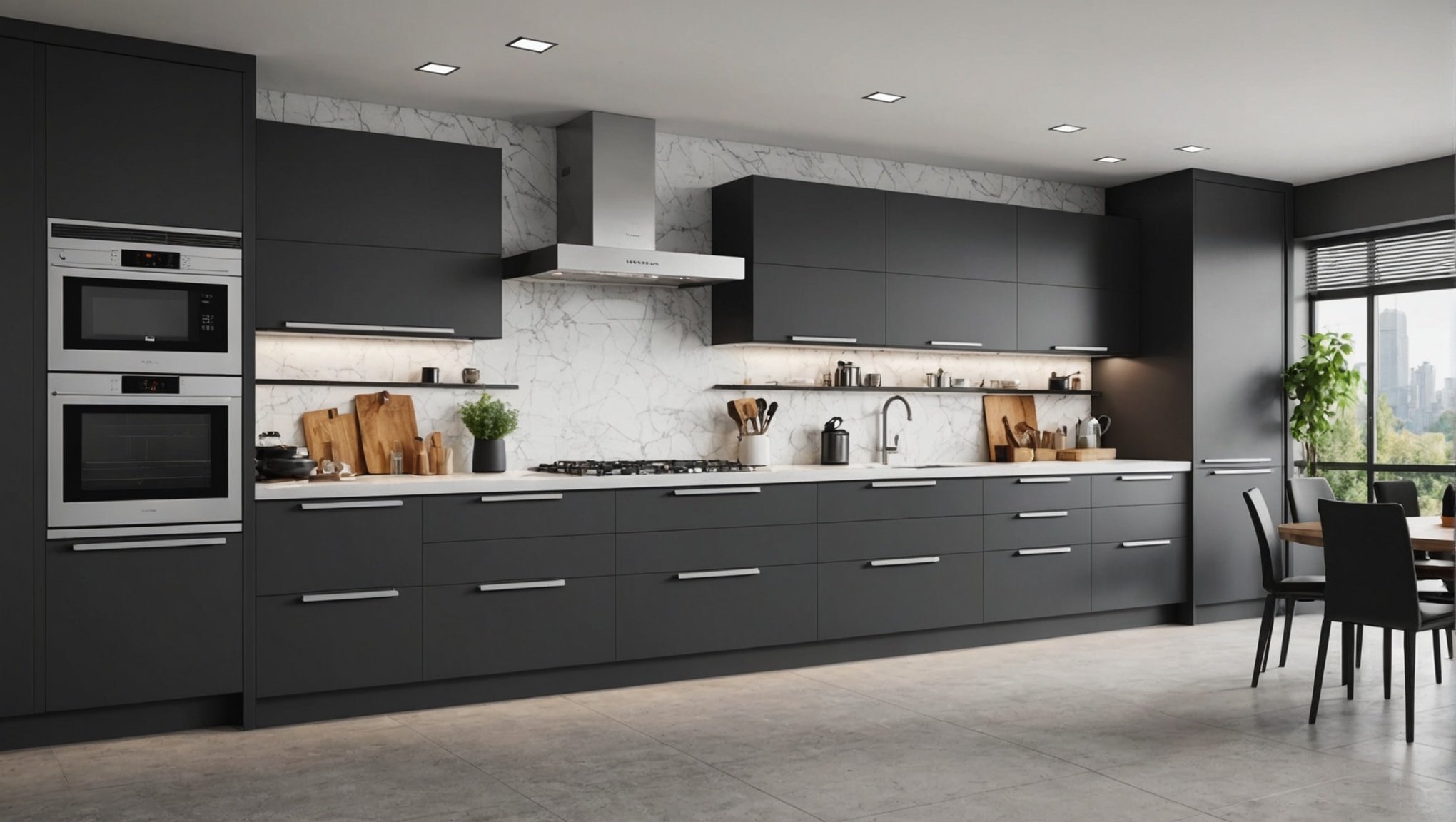Choosing the right range hood is essential for ensuring optimal grease protection in your kitchen. A well-selected range hood not only enhances air quality but also contributes to a cleaner, healthier cooking environment. Factors such as size, power, and noise level impact your culinary experience. This guide offers insights into the various types of range hoods, their features, and tips to help you make an informed decision tailored to your cooking habits and space. Say goodbye to unwanted grease buildup and enjoy a fresher kitchen today!
Understanding Range Hoods
Range hoods are essential kitchen appliances designed to enhance kitchen ventilation and maintain a clean environment. There are various range hood types available, each catering to different needs and kitchen setups. The most common types include ducted, ductless, wall-mounted, and under-cabinet range hoods.
Also to read : Mastering Kitchen Inventory: Streamline Your Supplies Management with Innovative Digital Solutions
Ducted range hoods are connected to an external vent, efficiently expelling smoke, odours, and airborne grease from the kitchen. They are ideal for kitchens with access to exterior walls. In contrast, ductless range hoods use filters to purify the air before recirculating it back into the kitchen. These are perfect for spaces where external venting is not feasible.
Wall-mounted range hoods are installed against a wall, often above a cooking range, while under-cabinet range hoods are fixed beneath kitchen cabinets, saving space and maintaining a sleek look.
Also to read : Choosing the ideal Champagne: key factors to consider
A crucial function of range hoods is grease protection. By trapping grease particles, they prevent build-up on kitchen surfaces, reducing fire hazards and keeping the kitchen cleaner. Furthermore, range hoods significantly improve indoor air quality by removing contaminants, ensuring a healthier cooking environment. This makes them an indispensable addition to any kitchen, promoting both safety and hygiene.
Key Features for Grease Protection
When selecting a range hood, understanding the types of grease filters is crucial. These filters are vital in trapping grease particles, ensuring a cleaner kitchen environment. The most common types include mesh and baffle filters. Mesh filters, often made of aluminium or stainless steel, are effective but require regular cleaning. Baffle filters, designed with overlapping layers, excel in capturing grease while allowing airflow, making them a popular choice for heavy cooking.
The airflow capacity, measured in cubic feet per minute (CFM), is another important consideration. A higher CFM rating indicates more efficient removal of smoke and odours. For optimal performance, choose a range hood with a CFM rating that matches your cooking style and kitchen size. For example, a busy kitchen with frequent frying might benefit from a higher CFM to ensure adequate ventilation.
Noise levels can significantly impact the kitchen experience. Range hoods with sound insulation features offer quieter operation, making them more pleasant to use. Consider models with variable speed settings, as they allow you to adjust the airflow and noise level according to your needs. By balancing grease protection, airflow, and noise considerations, you can select a range hood that enhances both safety and comfort in your kitchen.
Selecting the Right Size and Placement
Choosing the appropriate range hood sizing is crucial for optimal performance and aesthetics in your kitchen. The general rule is to select a hood that is at least as wide as your cooking surface. For instance, if you have a 30-inch stove, a 30-inch or wider range hood is recommended to ensure it effectively captures smoke and grease.
Installation height is another vital factor in maximizing the efficiency of your range hood. Typically, the recommended installation height ranges from 24 to 30 inches above the cooking surface for electric stoves, and 27 to 36 inches for gas stoves. This height ensures that the hood captures contaminants without being too close to the heat source, which could cause damage or reduce effectiveness.
Your kitchen layout also plays a significant role in range hood effectiveness. In a compact kitchen, an under-cabinet hood might be more suitable, while larger spaces with open layouts may benefit from a wall-mounted or island range hood. The layout determines how air flows and can influence the type of range hood that will best suit your needs. By considering these factors, you can ensure that your range hood not only fits seamlessly into your kitchen but also enhances its ventilation capabilities.
Installation Tips for Optimal Performance
Installing a range hood correctly is essential for its efficiency and longevity. For those considering a DIY installation, here is a step-by-step guide to help you through the process. First, ensure you have the right tools: a drill, screwdriver, measuring tape, and a level. Begin by marking the position of the hood on the wall or under the cabinet. Drill holes for mounting screws and, if necessary, cut an opening for ductwork.
Before securing the hood, attach any necessary ducting components. Once everything is aligned, secure the range hood in place and connect it to the power supply. Remember to check the manufacturer’s instructions for specific requirements and safety guidelines.
Despite the appeal of DIY, there are times when professional installation is advisable. If your kitchen requires complex ductwork or electrical modifications, hiring a professional can prevent costly mistakes.
Common installation mistakes include incorrect height placement and inadequate support for the hood’s weight. Ensure the hood is level and securely fastened to avoid vibrations and noise. By following these tips, you can achieve optimal performance and enjoy a well-ventilated kitchen environment.
Maintenance for Long-lasting Efficiency
Regular range hood maintenance is crucial for ensuring its long-term efficiency and performance. The key to effective maintenance lies in the routine cleaning and upkeep of the grease filters. Depending on your cooking frequency, it’s advisable to clean mesh filters every month and baffle filters every three months. This ensures that grease and grime do not accumulate, which could impair the hood’s functionality.
Filter replacement is another critical aspect of maintenance. For optimal performance, replace charcoal filters every three to six months, as they lose effectiveness over time. This replacement schedule ensures that the range hood continues to effectively purify the air in your kitchen.
In addition to filter care, maintaining the exterior and interior of the range hood is essential. Regularly wipe down the hood’s surface with a mild detergent to remove grease and dust. For the interior, ensure that the fan and ductwork are free from obstructions and build-up. This not only enhances the hood’s efficiency but also prolongs its lifespan.
By following these cleaning tips and replacement guidelines, you can keep your range hood in peak condition, ensuring a cleaner and healthier kitchen environment.
Top-Rated Range Hood Recommendations
Selecting the best range hoods can significantly enhance your kitchen’s ventilation and aesthetics. Based on comprehensive product reviews, we’ve identified top-rated models that balance performance and value.
Overview of Top-Rated Range Hoods
When considering a range hood, user feedback plays a crucial role. Brands like Broan, Zephyr, and Cosmo consistently receive high praise for their efficiency and design. These models excel in grease protection and offer various installation options to suit different kitchen layouts.
Comparison of Features and Prices
- Broan 413004: Known for its affordability, this ductless range hood features an aluminium mesh filter, making it suitable for smaller kitchens. Priced around £70, it provides reliable performance for budget-conscious buyers.
- Zephyr AK2100BS: A mid-range option, this ducted hood offers a powerful 600 CFM motor, ideal for heavy-duty cooking. At approximately £400, it combines sleek design with robust functionality.
- Cosmo QS75: For those seeking premium features, this model includes a digital touch control panel and a 900 CFM motor. Priced at about £600, it ensures superior air purification and noise reduction.
Buying Guide
When purchasing a range hood, consider factors like airflow capacity, noise levels, and ease of maintenance. Evaluate your cooking habits and kitchen size to determine the most suitable model. Investing in a high-quality range hood enhances both your kitchen’s functionality and your cooking experience.






